For one-handed photography, lightweight cameras with built-in stabilization like the Fujifilm X100VI or DJI Osmo Pocket 3 offer excellent control with minimal effort. Consider adaptive mounting systems for wheelchairs or specialized grips with thumb levers to enhance stability. Switch-activated cameras and Bluetooth remote shutters provide additional accessibility options. Voice controls and haptic feedback further simplify operation. The right equipment combination can dramatically transform both your comfort and creative possibilities.
Understanding One-Handed Camera Operation Challenges
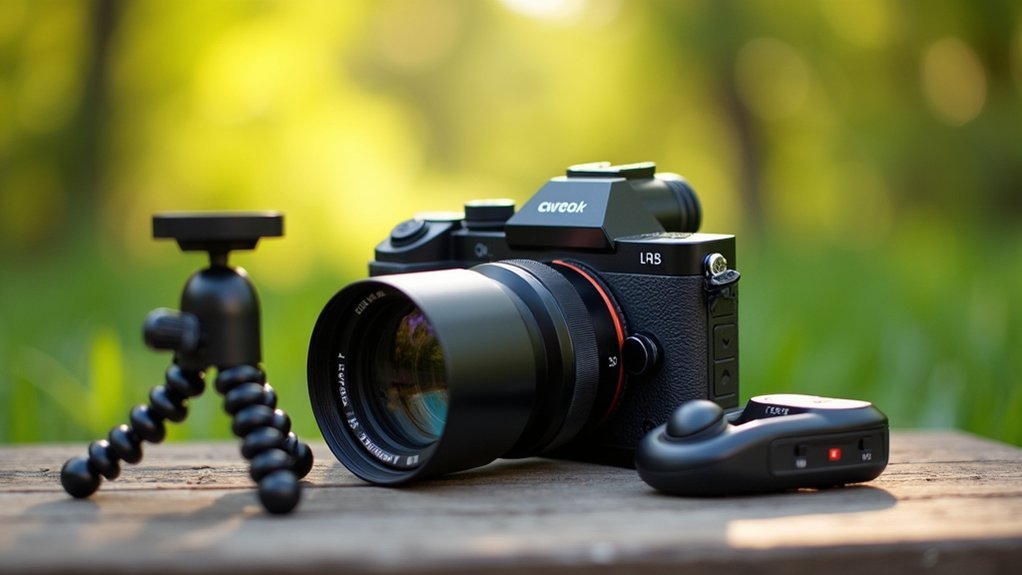
While the world of photography opens creative possibilities for everyone, photographers with the use of only one hand face unique challenges in handling equipment designed primarily for two-handed operation.
You’ll find that adjusting camera settings becomes tediously slow, requiring patience and practice.
Weight considerations are vital—lighter cameras like the Sony NEX6 are more manageable than bulkier models.
When working with one hand, every gram matters—choose lightweight cameras that won’t strain your balance or capabilities.
Standard tripods present setup difficulties, but monopods can provide essential stability with minimal setup effort.
Hand straps offer valuable security but require adaptation time.
Balance and stability remain ongoing concerns.
You can compensate by leveraging your body positioning and using available objects like walls or tables for support.
Camera ergonomics matter greatly—look for models with well-placed buttons and intuitive controls that don’t require simultaneous multi-button operations.
Prime lenses are generally easier to manage than zoom lenses due to their simpler handling and fixed focal length that eliminates the need for constant adjustments.
Lightweight Cameras With Built-In Stabilization Features
For photographers with one-handed abilities, camera weight becomes a critical factor that can determine your shooting success.
Look for compact cameras with large APS-C sensors that balance quality with manageable size and weight.
The Fujifilm X100VI offers in-body image stabilization (IBIS) with its bright f/2 lens and hybrid viewfinder—ideal for one-handed operation.
For ultimate portability, consider the RICOH GR III with its large sensor, though it lacks IBIS.
If you’re creating video content, the DJI Osmo Pocket 3’s three-axis gimbal provides exceptional stabilization.
These stabilized cameras allow you to shoot at slower shutter speeds with sharper results, especially valuable in low light. Image stabilization is considered one of the most important features in a digital camera for disabled photographers.
You’ll also benefit from smoother video footage and more creative freedom without sacrificing image quality or struggling with excessive weight.
Adaptive Mounting Systems for Wheelchairs and Mobility Aids
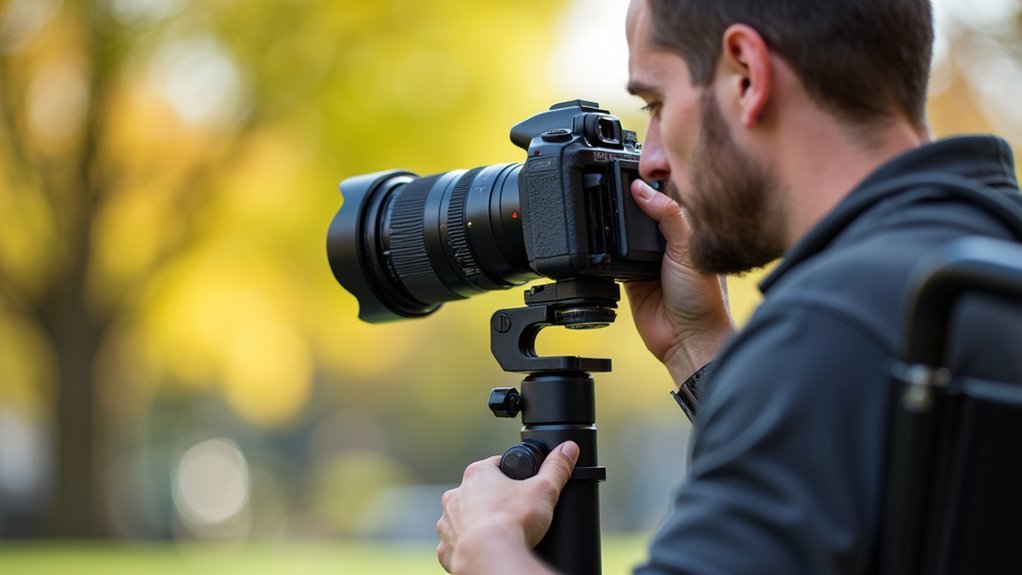
Numerous photographers who use wheelchairs or mobility aids need specialized mounting solutions to successfully operate cameras with one hand.
Heavy-duty options like the ALZO Wheelchair Camera Mount provide all-metal construction that securely supports your equipment while offering flexibility.
You’ll find various attachment methods including armrest and seat track mounting systems with quick disconnect features for easy setup and removal.
Look for mounts with tool-free adjustments and customizable lock positions that allow you to position your camera precisely where you need it.
The ALZO Camera Flipper included with wheelchair mounts enables rapid 90-degree repositioning from landscape to portrait orientation for versatile shooting.
The best adaptive mounts offer adjustable resistance in their joints, preventing accidental movement while still allowing one-handed position changes.
Many systems include tilt adjustments from 0 to 110 degrees and resistant hinges that prevent your expensive gear from slamming down unexpectedly.
Single-Switch and Simplified Control Camera Options
Switch-activated cameras like CanAssist and QED models offer you photography control through single large buttons or external accessibility switches.
You’ll find these specialized cameras provide essential photographic capabilities while accommodating limited dexterity through one- or two-switch operation. These cameras typically feature a durable aluminum enclosure that allows for reliable mounting on various platforms.
The simplified control systems often include customizable audio and visual feedback to support your specific needs while maintaining compatibility with standard accessibility switches like the “Jelly Bean.”
Switch-Activated Shutter Models
Photographers with limited mobility can now access specially designed cameras that operate with a single switch or button. These devices connect via standard 3.5mm jacks, making them compatible with various external switches you might already own. Some models feature built-in memory with expandable storage options through micro SD card slots.
| Camera Model | Key Features | Mounting Options |
|---|---|---|
| CanAssist | Large button control, disability-focused | RAM mounts, wheelchair compatible |
| Vtech Kidizoom | 2.0MP, digital zoom, switch-adapted | GorillaPod, flexible positioning |
| Adapted Digital | Standard camera features with switch control | Manfrotto Variable Friction Arm |
| Custom Solutions | Mainstream cameras with aftermarket adaptations | Gooseneck mounts, power wheelchair attachments |
These switch-activated cameras offer you creative expression while simplifying the photography process. Most models include battery-saving features like automatic shutdown and can be securely mounted to your wheelchair for stable shooting in various environments.
One-Touch Control Systems
A revolutionary step beyond basic switch activation, one-touch control systems offer you extensive camera operation through minimal physical input.
These systems enable single-button photography while providing compatibility with various assistive devices like bite controllers, tongue switches, and sip/puff mechanisms.
You’ll find cameras that integrate seamlessly with your existing assistive technology, whether you’re using a Jouse2 mouth joystick or voice command software.
Many models include standard mounting holes for attachment to wheelchairs or tripods, ensuring stability during use.
For enhanced functionality, consider tethering your camera to a computer using Capture One software, which allows complete control via a larger screen.
This setup works particularly well if you’re using head-controlled systems or have limited dexterity but can operate a modified mouse or touchscreen.
Companies like QED and RJ Cooper have developed specialized Switch Adapted Digital Cameras that require minimal cognitive effort to operate.
Specialized Grips and Thumb Lever Systems for Enhanced Control
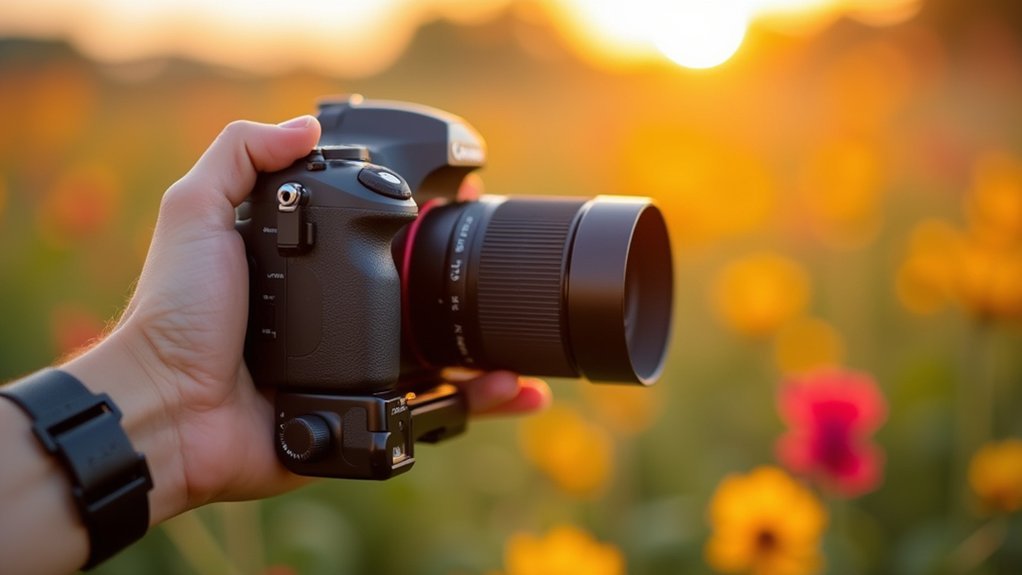
For disabled photographers seeking enhanced camera control, specialized grips and thumb lever systems offer remarkable solutions to common handling challenges.
Adaptive handles like the Oben camera grip open up your hand to reduce cramping, while adding hockey tape provides better traction for limited dexterity.
Ergonomic grips and textured surfaces transform camera handling, giving photographers with mobility challenges better control with less physical strain.
Thumb lever systems effectively distribute weight and allow you to trigger the shutter without extensive hand movement. When paired with wheelchair RAM mounts, these systems create a thorough control solution.
- Use ergonomic grips to minimize hand fatigue during extended shooting sessions
- Install thumb controls to adjust settings without changing your grip position
- Combine with padded straps to distribute weight away from your hands
- Consider monopod attachments for your wheelchair to create a stable mobile platform
Camera Weight Distribution Solutions for Limited Dexterity
You’ll find thumb lever systems particularly valuable for single-handed camera operation, offering intuitive control without requiring full grip strength.
These adaptive controls can be positioned strategically on your camera rig where your thumb naturally rests, enabling easy access to essential functions like shutter release and focus adjustment.
Specialized grip solutions complement these systems by providing customized contact points that work with your unique hand capabilities rather than against them. For front-heavy lens setups, an eazy handle can significantly improve balance while maintaining single-handed control capability.
Thumb Lever Systems
Thumb lever systems represent a breakthrough solution for photographers with limited dexterity, offering innovative weight distribution mechanisms that transform how disabled photographers handle their equipment.
These ergonomically designed systems redistribute camera weight to reduce hand strain while providing intuitive operation even with limited finger movement. Many photographers with disabilities find that these systems offer tool-free installation similar to gaming accessories, making them accessible without requiring assistance.
The primary benefits include:
- Enhanced control over camera movements without requiring full hand dexterity
- Reduced fatigue through balanced weight distribution across your hand
- Seamless integration with existing equipment including tripods and monopods
- Adjustable components that can be customized to your specific mobility needs
When selecting a thumb lever system, look for high-quality materials and ergonomic designs that complement your existing gear while addressing your particular dexterity challenges.
Adaptive Grip Solutions
Photographers with limited dexterity face unique challenges that adaptive grip solutions effectively address through innovative weight distribution mechanisms and ergonomic designs. You’ll find specialized camera hand grips at retailers like Best Buy that enhance stability while reducing strain on your hands. Among these options, gimbals like the DJI RS series provide excellent 3-axis stabilization for smooth video capture despite hand tremors or limited grip strength.
| Solution Type | Benefits | Best For |
|---|---|---|
| Soft Molded Grips | Improved comfort, built-in straps | Daily shooting |
| Pneumatic Grippers | Adaptable fingers, customizable grip | Studio work |
| Foam Tubing | Inexpensive, easy to install | Entry-level users |
Consider weight distribution solutions that optimize camera balance for easier handling. Ergonomic designs with adjustable grip sizes accommodate different hand capabilities, while adaptive mounts secure your gear to stable objects. The Active Hands Company and Functionalhand offer universal cuffs that provide independence for photographers with limited hand mobility.
Innovative Assistive Technologies for Photography Accessibility
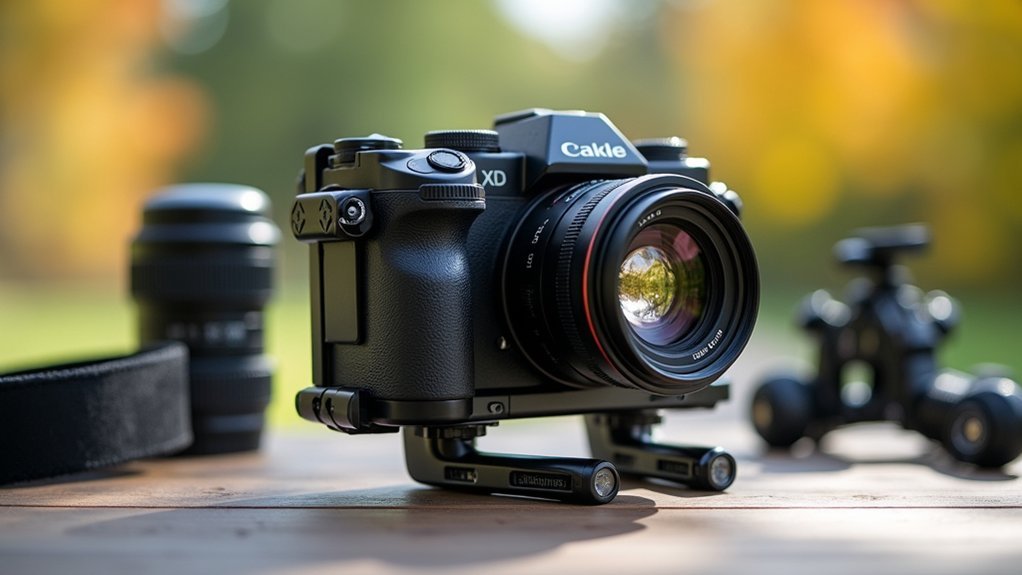
While traditional camera equipment often presents significant barriers, innovative assistive technologies are revolutionizing photography accessibility for disabled photographers. Voice-activated controls and Bluetooth remote shutters eliminate the need to physically press buttons, giving you newfound creative freedom with just one hand.
For visually impaired photographers, modern solutions provide vital feedback through:
- Audio guidance systems that describe framing and composition in real-time
- Haptic vibrations indicating when focus is achieved or exposure is set
- AI-powered scene recognition that verbally identifies subjects in your frame
- Smartphone apps with customizable interfaces featuring larger controls and simplified layouts
These technologies don’t just accommodate limitations—they actively enhance your creative potential by eliminating unnecessary physical demands and providing alternative ways to capture perfect shots. With approximately 61 million adults in the U.S. living with some type of disability, these adaptable photography tools help ensure equal access to creative expression.
Frequently Asked Questions
Is Insurance Coverage Available for Adaptive Photography Equipment?
Yes, you’ll find insurance coverage for adaptive photography equipment through specialized providers like Full Frame Insurance and organizations such as PPA. You can customize policies to cover your unique adaptive gear against damage, theft, and loss.
How Can Photographers With Disabilities Join Accessible Photography Communities?
You can join accessible photography communities through online forums, social media groups, local workshops, organizations like the Disabled Photographers’ Society, and virtual workshops that accommodate different accessibility needs and learning styles.
What Are Travel Considerations When Flying With Adaptive Camera Gear?
When flying with adaptive camera gear, you’ll need to plan for TSA screening, check airline policies, and protect your equipment. Contact airlines in advance about your specialized gear and bring necessary documentation for smoother travel.
Can Adaptive Camera Equipment Be Rented Before Purchasing?
Yes, you can rent adaptive camera equipment, though availability is limited. Check with specialized camera shops, non-profit organizations, or online communities for disabled photographers. Consider trying before buying to guarantee it meets your needs.
Are There Photography Workshops Specifically Designed for Disabled Photographers?
Yes, you’ll find several workshops tailored for disabled photographers, including Photographers With Disabilities, Hearts & Lens, Shooting Beauty, Disability/Visibility, and Beginning Photography for Adults with Disabilities. Each offers specialized training and accessible facilities.
In Summary
You’re not alone in your photography journey despite the challenges of one-handed operation. Today’s adaptive gear offers real solutions—from lightweight cameras with enhanced stabilization to specialized mounts and simplified controls. As technology continues to evolve, you’ll find even more innovative options that prioritize accessibility without compromising quality. Remember, the best camera setup is the one that works for your specific needs and creative vision.

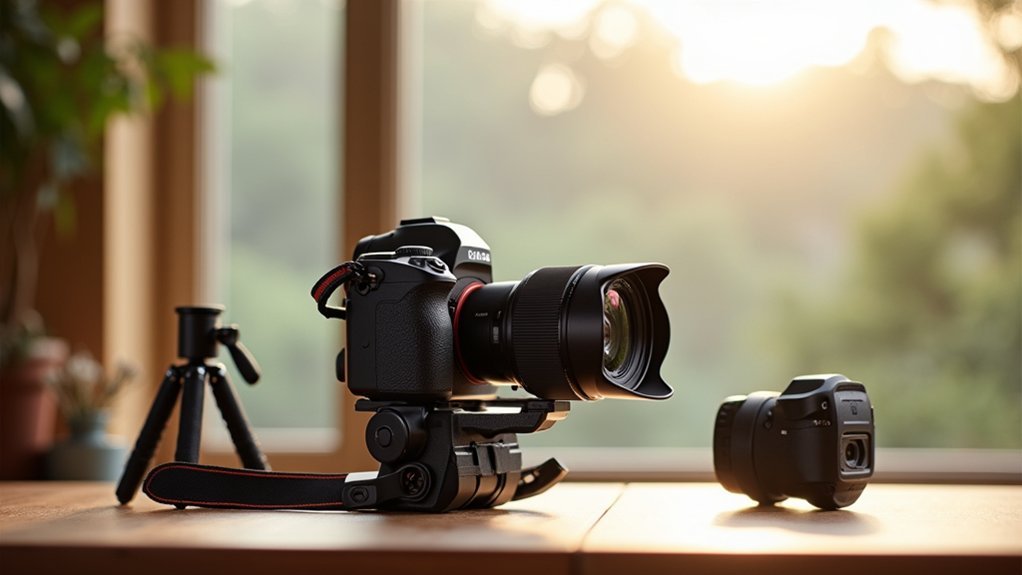



Leave a Reply